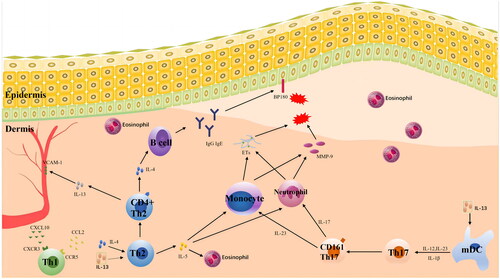Figures & data
Figure 1. A network of cytokines affects the pathogenesis of BP. The pathogenesis of BP is primarily associated with cytokines related to Th2 and Th17. IL-4, IL-5 and IL-13 cause the recruitment of eosinophils, stimulate the production of antibodies, induce pruritus, promote blister formation and cause other symptoms. IL-17 and IL-23 stimulate the production of matrix metalloproteinase-9 (MMP-9) by related cells, which leads to dermo-epidermal junction (DEJ) separation and the formation of bullae and blisters and can persist in BP inflammation. The serum concentrations of IL-17 and IL-23 are associated with the prognosis of BP.

Data availability statement
The datasets used and/or analysed during the current study available from the corresponding author on reasonable request.
